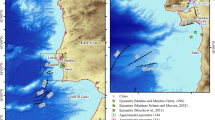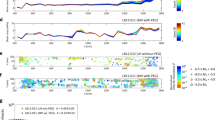Abstract
We have compared near-fault ground motions from TeraShake simulations of Mw7.7 earthquake scenarios on the southern San Andreas Fault with precariously balanced rock locations. The TeraShake scenarios with different directions of rupture generate radically different ground motions to the northwest of the Los Angeles Basin, primarily because of directivity effects, and thus provide constraints on the ground motion and rupture direction for the latest (1690) large event on that section of the San Andreas Fault. Due to the large directional near-field ground motions predicted by the simulations, we expect the precariously balanced rocks to be located primarily in the backward rupture direction or near the epicenter. Preliminary results favor persistent nucleation at or slightly northwest of the San Gorgonia Pass fault zone for large earthquakes on the southern San Andreas Fault.
Similar content being viewed by others
References
Abrahamson NA, Somerville PG (1996) Effects of the hanging wall and footwall on ground motions recorded during the Northridge earthquake. Bull Seis Soc Am 86:593–599
Andrews JD (1999) Test of two methods for faulting in finite-difference calculations. Bull Seis Soc Am 89:931–937
Bell JW, Brune JN, Zeng Y (2004) Methodology for obtaining constraints of ground motion from precariously balanced rocks. Bull Seis Soc Am 94:285–303
Benites R, Olsen KB (2005) Modeling strong ground motion in the Wellington Metropolitan area, New Zealand. Bull Seis Soc Am 95:2180–2196
Day SM, Bradley CR (2001) Memory-efficient simulation of anelastic wave propagation. Bull Seism Soc Am 91:520–531
Freed AM, Lin J (2002) Accelerated stress buildup on the southern San Andreas Fault and surrounding regions caused by Mojave Desert earthquakes. Geology 30:571–574
Graves RW and Pitarka A (2004) Broadband time history simulation using a hybrid approach. Proceedings of the 13th World Conference on Earthquake Engineering, Vancouver, Canada, August 1–6, 2004, Paper No. 1098.
King G, Stein R, Lin J (1994) Static stress changes and the triggering of earthquakes. Bull Seis Soc Am 84:935–953
Liu P-C, Archuleta RJ, Hartzell SH (2006) Prediction of broadband ground-motion time histories: hybrid low/high-frequency method with correlated random source parameters. Bull Seis Soc Am 96:2118–2130
Mai PM, Olsen KB (2006) Near-field broadband ground motions based on low-frequency finite-difference synthetics merged with high-frequency scattering operators. Seis Res Lett 77:300
Magistrale H, Day SM, Clayton R, Graves RW (2000) The SCEC southern California reference three-dimensional seismic velocity model version 2. Bull Seis Soc Am 90(6B):S65–S76
Marcinkovich C, Olsen KB (2003) On the implementation of perfectly matched layers in a 3D fourth-order velocity-stress finite-difference scheme. J Geophys Res 108(B5):2276
Nicholson C (1996) Seismic behavior of the southern San Andreas Fault zone in the Coachella Valley, California: comparison of the 1948 and 1986 earthquake sequences. Bull Seis Soc Am 86:1331–1349
Oglesby DD, Dreger DS, Harris R, Ratchkovski N, Hansen R (2004) Inverse kinematic and forward dynamic models of the 2002 Denali, Alaska earthquake. Bull Seis Soc Am B6:S214–S233
Olsen KB (1994) Simulation of three-dimensional wave propagation in the Salt Lake Basin, Ph.D. Thesis, University of Utah, Salt Lake City, Utah, 157 pp
Olsen KB, Day SM, Bradley CR (2003) Estimation of Q for long-period (>2 s) waves in the Los Angeles Basin. Bull Seis SocAm 93:627–638
Olsen KB, Day SM, Minster JB, Cui Y, Chourasia A, Faerman M, Moore R, Maechling P, Jordan T (2006) Strong shaking in Los Angeles expected from southern San Andreas earthquake. Geophys Res Lett 33:L07305 DOI 10.1029/2002JB002235
Olsen KB, Day SM, Minster JB, Cui Y, Chourasia A, Okaya D, Maechling P and Jordan T (2008) Spontaneous rupture simulations of Mw7.7 earthquakes on the southern San Andreas fault. Bull Seis Soc Am (in press)
Peyrat S, Olsen KB, Madariaga R (2001) Dynamic modeling of the 1992 Landers earthquake. J Geophys Res 106:26,467–26,482
Purvance MD (2005) Overturning of slender blocks: numerical investigation and application to precariously balanced rocks in southern California, PhD Dissertation, University of Nevada, Reno
Purvance MD, Brune JN, and Anooshehpoor A (2005) Attenuation relation consistency with precariously balanced rocks, Proceedings 2005 SCEC Conferenece, Palm Springs, CA, Sept. 11–14.
Weldon R, Scharer K, Fumal T, Biasi G (2004) Wrightwood and the earthquake cycle: what a long recurrence record tells us about how faults work. Geol Seis Am 14:4–10
Working Group on California Earthquake Probabilities Seismic hazards in southern California: probable earthquakes, 1994 to 2024, 1995. Bull Seis Soc Am 85:379–439
Author information
Authors and Affiliations
Corresponding author
Rights and permissions
About this article
Cite this article
Olsen, K., Brune, J. Constraints from precariously balanced rocks on preferred rupture directions for large earthquakes on the southern San Andreas Fault. J Seismol 12, 235–241 (2008). https://doi.org/10.1007/s10950-007-9078-7
Received:
Accepted:
Published:
Issue Date:
DOI: https://doi.org/10.1007/s10950-007-9078-7




